https://tinyurl.com/y3s2rk7e
A semantic, pragmatic excursus
Annex details the importance of gmelina arborea tree as a wealth-producing tree with its wood used for boat building by seafaring merchants of the civilization.
A unique mold-made faience tablet or standard (H2000-4483/2342-01) was found in the eroded levels west of the tablet workshop in Trench 54 of Harappa by HARP Team. On one side is a short inscription under a rectangular box filled with 24 dots. The reverse has a narrative scene with two bulls fighting under a thorny tree.
Source: https://www.harappa.com/indus3/205.html ![]() Leaves. Gmelina arborea
Leaves. Gmelina arboreaSee: A tablet shaped like a gmelina arborea leaf with Indus Script bas-relief inscription of a silversmith's lapidary metalwork repertoire
https://tinyurl.com/y3nfxyk7
In the context of the shape of gmelina arborea used for a Harappa tablet which is an Indus Script catalogue of metalwork, I suggest that the spoken form of the gmelina arborea tree signified by its unique leaf shape should be read as:
kumuda 'gmelina arborea leaf' rebus: kumuda 'silver'. The tablet is inscribed in bas-relief; the term for such writing is: குமிழ்-தல் kumiḻ- , 4 v. intr. To be embossed or worked in relief; சித்திரவேலைசெதுக்கப்படுதல். மரத்திற்குமிழ்ந்த்யானை.
Thus, the kumir̤, kumuda, gmelina arborea leaf also signifies bas-relief writing, in addition to the rebus rendering of कु-मुद'silver' (Skt.)(Monier-Williams).
The word kumuda (Skt.),kumutai (Tamil)gets phonetic transformations in Indian sprachbund(speech union) as evidenced in the following variant Meluhha, mleccha pronunciations.
Skt. (lex.) kumudā- G. arborea (cited in DEDR 1742)
குமுதை kumutai n. 1. Coomb teak, Gmelina arborea; குமிழ்மரவகை. Pond. (Tamil)
umbudi G. asiatica (Kannada)
gummudu G. arborea, G. asiatica (Telugu)
gummur G. arborea (Gondi)
kumbili G. arborea(Koḍ)
gamhar, gombhar (Some dialects in Kashmir)
gamhārī ʻ a partic. kind of tree (Bhojpuri). It is this pronunciation which is mentioned in some texts referring to the gmelina arborea tree as gamhar.
(German) : Gumar-Teak
(Hindi) : gambhar, gomari, gumhar, kambhari, sewan
(Nepali) : gamari, gambari, gumhari, khamari
(Sanskrit) : bhadraparni, gambhari, gandhari, kasmari, shriparni
Thus, the range of pronunciations from kumuda to gamhar have been explained as dialectical pronunciation variants characteristic of Meluhha, mleccha speech in various parts of Ancient India. The reference to kasmari in Skt. Indicates the provenance of the tree in Kashmir region. (Several synonyms occur in Skt.)
Some common names of gmelina arborea tree in a number of languages
(Bengali) : gamar, gamari, gomari, gumbar, gumhar
(Burmese) : mai saw, yemane, yemani, yemari
(English) : beechwood, gmelina, goomar teak, Kashmir tree, Malay beechwood, white teak, yemane
(French) : gmelina, melina, peuplier d Afrique
(German) : Gumar-Teak
(Hindi) : gambhar, gomari, gumhar, kambhari, sewan
(Nepali) : gamari, gambari, gumhari, khamari
(Sanskrit) : bhadraparni, gambhari, gandhari, kasmari, shriparni
(Spanish) : gmelina, melina
(Tamil) : gumadi, kumadi, perungumpil, umi-thekku
(Thai) : so, so-maeo
(Trade name) : gumhar, yemane
(Vietnamese) : l[ox]I th[oj], nghi [ees]n d[aas]t
Ta. kumir̤ coomb teak, small cashmere tree; kūmpal coomb teak, Gmelina arborea. Ma. kumir̤, kumpiḷ G. asiatica. Ka.(Lush.) kumuḷe, kumbuḍi, kūḷe G. arborea. Koḍ. kummi, kumbïḷi id. Te. (Lush.) gummuḍu, gumuḍu G. arborea and asiatica; (Inscr.) kumaḍu G. arborea. Kol. (Kin.) kumre G. arborea. Pa. gumṛi id. Go. (Tr.) gummur marā the kumīn tree, Careya arborea (Voc. 1149); (Koya Lush.) gumudu G. arborea; (LuS.) koomooree the koombhee tree. / Cf. Skt. (lex.) kumudā- G. arborea. (DEDR 1742) कु-मुदा f. the plant Gmelina arborea (Monier-Williasms) कुमुदिक kumudika कुमुदिक a. Abounding in Kumudas. -का N. of a plant (कट्फला). -2 A small tree (the seeds to which are aromatic).कुमुदः-गन्ध्या f. a woman having the smell of a कुमुद to her body. (Apte) குமுதை kumutai n. 1. Coomb teak, Gmelina arborea; குமிழ்மரவகை. Pond. (Tamil)
Annex: Importance of gmelina arborea tree
“Gmelina arborea, (in English beechwood, gmelina, goomar teak, Kashmir tree, Malay beechwood, white teak, yemane[2] ), locally known as gamhar, is a fast-growing deciduous tree, occurring naturally throughout greater part of India at altitudes up to 1,500 meters. It also occurs naturally in Myanmar, Thailand, Laos, Cambodia, Vietnam and in southern provinces of China... In India, Gmelina arborea occurs extensively from the Ravi eastwards in the sub-Himalayan tracts, common throughout Assam and adjoining areas of northern West Bengal, also in southern Bihar and Odisha, sporadically found in western and southern India and planted elsewhere on a large scale. Gamhar most commonly occurs in West Bengal forests in mixed forests… Gmelina arborea timber is reasonably strong for its weight. It is used in constructions, furniture, carriages, sports, musical instruments and artificial limbs. Once seasoned, it is a very steady timber and moderately resistant to decay and ranges from very resistant to moderately resistant to termites. .
Bark of gmelina arboreatree
Flower of gmelina arborea tree
Its timber is highly esteemed for door and window panels, joinery and furniture especially for drawers, wardrobes, cupboards, kitchen and camp furniture, and musical instruments because of its lightweight, stability and durability. It is also used for bentwood articles. In boat building it is used for decking and for oars. Gmelina arborea is a popular timber for picture and slate frames, turnery articles and various types of brush backs, brush handles and toys also for handles of chisels, files, saws, screw drivers, sickles etc. The wood is also used for manufacturing tea chests and general purpose plywood, blackboards, frame core and cross bands of flushdoor shutters. In the instrument industry gambhar timber is widely employed for the manufacture of drawing boards, plane tables, instrument boxes, thermometer scales and cheaper grade metric scales. It is also used in artificial limbs, carriages and bobbins. It is an approved timber for handles of tennis rackets, frames and reinforcements of carom boards and packing cases and crates. Gamhar is used in papermaking and matchwood industry too.
· GAMHAR (Gmelina arborea): Indian Council of Forestry Research and Education, Dehradun
Ta. kumir̤ coomb teak, small cashmere tree; kūmpal coomb teak, Gmelina arborea. Ma. kumir̤, kumpiḷ G. asiatica. Ka. (Lush.) kumuḷe, kumbuḍi, kūḷe G. arborea. Koḍ. kummi, kumbïḷi id. Te. (Lush.) gummuḍu, gumuḍu G. arborea and asiatica; (Inscr.) kumaḍu G. arborea. Kol. (Kin.) kumre G. arborea. Pa. gumṛ iid. Go. (Tr.) gummur marā the kumīn tree, Careya arborea (Voc. 1149); (Koya Lush.) gumudu G. arborea; (LuS.) koomooree the koombhee tree. / Cf. Skt. (lex.) kumudā- G. arborea.(DEDR 1742)
gambhārī f. ʻ the tree Gmelina arborea ʼ lex. [See kārṣmaryà]
Bhoj. gamhārī ʻ a partic. kind of tree ʼ.
शिवण or णी śivaṇa or ṇī f A timber-tree, Gmelina arborea. Rox. The wood is light yet strong. It is much used in the Konkan̤ for net-floats.
स्थूल sthūla स्थूल a. (compar. स्थवीयस् superl. स्थविष्ठ) 1 Large, great, big, bulky, huge; बहुस्पृशापिस्थूलेनस्थीयतेबहिरश्मवत्Śi.2.78 (where it has sense 6 also); स्थूलहस्तावलेपान् Me.14,18; R.6.28. --तालः the marshy date-tree. -त्वचा Gmelina Arborea (Mar. थोरशिवणी).
सिन्धुः sindhuḥ सिन्धुः [स्यन्द्-द्-अद्संप्रसारणंदस्यधश्च Tv.; Uṇ.1.11] 1 The sea, ocean; तावत्त्रिभुवनंसद्यःकल्पान्तैधितसिन्धवः Bhāg. 3.11.3. -2 The Indus. -3 The country around the Indus. -पर्णी, -वेषणम् Gmelina Arborea (Mar. थोरशिवणी). –
karmāˊra m. ʻ blacksmith ʼ RV. [EWA i 176 < stem *karmar -- ~ karman -- , but perh. with ODBL 668 ← Drav. cf. Tam. karumā ʻ smith, smelter ʼ whence meaning ʻ smith ʼ was transferred also to karmakāra -- ]Pa. kammāra -- m. ʻ worker in metal ʼ; Pk. kammāra -- , ˚aya -- m. ʻ blacksmith ʼ, A. kamār, B. kāmār; Or. kamāra ʻ blacksmith, caste of non -- Aryans, caste of fishermen ʼ; Mth. kamār ʻ blacksmith ʼ, Si. kam̆burā.*karmāraśālā -- .Addenda: karmāˊra -- : Md. kan̆buru ʻ blacksmith ʼ.*karmāraśālā ʻ smithy ʼ. [karmāˊra -- , śāˊlā -- ]Mth. kamarsārī; -- Bi. kamarsāyar?(CDIAL 2898, 2899)
Species identity
Taxonomy
Current name: Gmelina arborea
Authority: Roxb.
Family: Verbenaceae
Synonym(s)
Gmelina arborea Roxb. var. canescens Haines
Gmelina arborea Roxb. var. glaucescens C. B. Clarke
Gmelina rheedii Hook.
Common names
(Bengali) : gamar, gamari, gomari, gumbar, gumhar
(Burmese) : mai saw, yemane, yemani, yemari
(English) : beechwood, gmelina, goomar teak, Kashmir tree, Malay beechwood, white teak, yemane
(French) : gmelina, melina, peuplier d Afrique
(German) : Gumar-Teak
(Hindi) : gambhar, gomari, gumhar, kambhari, sewan
(Nepali) : gamari, gambari, gumhari, khamari
(Sanskrit) : bhadraparni, gambhari, gandhari, kasmari, shriparni
(Spanish) : gmelina, melina
(Tamil) : gumadi, kumadi, perungumpil, umi-thekku
(Thai) : so, so-maeo
(Trade name) : gumhar, yemane
(Vietnamese) : l[ox]I th[oj], nghi [ees]n d[aas]t
Botanic description
Gmelina arborea is an unarmed, moderately sized to large deciduous tree with a straight trunk. It is wide spreading with numerous branches forming a large shady crown, attains a height of 30 m or more and a diameter of up to 4.5 m. Bark smooth, pale ashy-grey or grey to yellow with black patches and conspicuous corky circular lenticels. Inside surface of bark rapidly turns brown on exposure and exfoliates into thick woody plates or scurfy flakes. Blaze pale orange and mottled with a darker orange colour. Leaves opposite-decussate, mostly rather soft and limp; petioles cylindrical, 5-15 cm long, puberulent or glabrous; leaf blades broadly ovate, 10-25 cm x 7-20 cm wide, apically long acuminate or caudate, entire on mature plants but strongly toothed or lobed on young plants, usually cordate or trunkate basally, with a short cuneate attenuation into the petiole, densely tomentose above when young, becoming glabrous above when mature, permanently densely fulvulous-tomentellous with stellate hairs beneath, glanduliferous just above the petiole on the basal attenuation. Flowers abundant, scented, reddish, brown or yellow, in terminal and axillary 1- to-3-flowered cymes on the panicle branches, which are about 8-40 cm long. Flower 2.5-5 cm in diameter; bracts 8 mm long, linear lanceolate; calyx broadly campanulate, about 5 mm long, densely fulvous-tomentose externally, the rim with 5 small, triangular, acute teeth; corolla large, showy, varying from yellow to orange or brilliant orange to reddish- or brownish-yellow, dull yellow-brown, tubular below, obliquely funnel-form at the throat, the tube densely pubescent externally, the limb 2-lipped, the upper lip often orange-pink, deeply divided into 2 oblong, obtuse, backwardly curled lobules, the lower lip often lemon yellow, up to twice as long as the upper and 3-lobed. Fruit a drupe, 1.8-2.5 cm long, obovoid, seated on the enlarged calyx, glossy and yellow when ripe; exocarp succulent and aromatic; endocarp bony and usually 2-celled. Seeds 1-3, lenticular, exalbuminous. The genus was named after J.C. Gmelin, an 18th-century German botanist. The specific name means treelike, from the Latin ‘arbor’ (tree).Ecology and distribution
History of cultivation
G. arborea was first introduced from Myanmar as a fast-growing tree species into forest plantations of Peninsular and East Malaysia. It was also introduced to other ASEAN countries, such as the Philippines and Indonesia. G. arborea has since been introduced into many countries worldwide and large-scale plantations are found in Central and East Africa, West Africa and South Africa.
Natural Habitat
The species occurs in a variety of forest habitats, including tropical semi-evergreen, sub-montane, very moist teak forests, deciduous, sal and dry teak forests. It also occurs in Syzygium parkland and low alluvial savannah woodland. The tree is a light demander, although it can stand some shade. It is moderately frost hardy and recovers quickly from frost injuries. G. arborea occurs in the western Himalayas. Its choice of site is wide, but it shows a preference for moist fertile valleys with sandy loam soil; in west Bengal, this species grows best on high silt deposits near rivers. It does not thrive where the drainage is poor, while on dry, sandy or otherwise poor soil it remains stunted and is apt to assume little more than a shrubby form because of repeated dying back through drought.
Geographic distribution
Native : Bangladesh, Cambodia, China, India, Japan, Laos, Myanmar, Nepal, Pakistan, Sri Lanka, Thailand, Vietnam
Exotic : Brazil, Cote d'Ivoire, Ethiopia, Gambia, Ghana, Kenya, Malawi, Malaysia, Nigeria, Sierra Leone, Sudan, Tanzania, Uganda, Zambia
Biophysical limits
Altitude: 0-1200 m, Mean annual temperature: 38-48 deg. C, Mean annual rainfall: 750-4500 mm Soil type: Preference for moist, fertile, freely drained soils; acid soils, calcareous soils and laterite soils.
Reproductive Biology
Seed years recorded from various locations show that the tree seeds well every year. There are 2 peak periods for floral bud burst, which may vary from year to year, and with the local climatic conditions. The first flowers are borne 3-4 years after planting and, in nature, self-pollination is discouraged by the floral morphology. However, in controlled self-pollination, flowers develop into fruits. Many types of insects visit the flower showing that the flowers may be insect-pollinated. Birds and bats, attracted by the smell of fruits, are the main seed dispersal agents. Mature fruits are produced 1 week after flowering peak and fruiting may be spread over a 2-month period. In India, the species flowers from February to March and fruits ripen from the end of April to June. Propagation and management
Propagation methods
Normally, seed is collected from the ground, depulped and the stones are dried. Pretreatment is not necessary. For quick germination, the seeds should be soaked for 48 hours. The seeds germinate within 20-50 days under ideal conditions; the average rate for a healthy seed lot is 60%. Trees can be raised easily by transplanting, which is carried out in the rainy season, or by direct sowing in lines; the latter has proved to be more successful in some instances. Large cuttings planted during the rainy season do well.
Tree Management
G. arborea has suitable characteristics for agroforestry, with fast growth, ease of establishment, and relative freedom from pests outside its natural range (it can be browsed repeatedly without damage). It is an especially promising fuelwood species because it can be established easily, regenerates well from both sprouts and seeds, and is fast growing. Trees coppice well with vigorous shoot growth. Although able to compete with weeds more successfully than many other species, it responds positively to weeding and also benefits from irrigation.
Germplasm Management
Viable seeds should be collected from standing trees of superior phenotype. Seed storage behaviour is orthodox; viability can be maintained for several years in hermetic storage at 3 deg. C with 7-10% mc. On average, there are 1400 seeds/kg. Functional uses
Products
Food: The fruit of G. arborea is edible. Fodder: Leaves are regarded as good fodder and cattle eat the fruit. Fuel: G. arborea is planted mostly for firewood, which has a calorific value of 4800 kcal/kg. For firewood, a spacing of 2 x 2 m is recommended. Plantations of G. arborea have been established for tobacco curing. Apiculture: Flowers produce abundant nectar, which produces high-quality honey. Fibre: The wood produces good-quality pulp. Unmixed semi-chemical pulp is suitable only for carton board or low-grade writing paper, but kraft pulp of yemane wood is suitable for higher grades of writing paper. It is also utilized for particle board. Timber: When 1st cut, the wood is yellowish- to reddish-white, turning light russet or yellowish-brown with a density of 400-560 kg/cubic m. The wood seasons well without degrading, but it is slow to dry both in the open and in a kiln. Where it is indigenous, it is regarded as a valuable general-purpose wood because of its dimensional stability. The natural durability of the wood is about 15 years. Uses include the manufacture of furniture, plywood core stock, mine props, matches and timber for light construction. Tannin or dyestuff: Both wood ash and fruit yield a very persistent yellow dye. Medicine: Bark, leaves and roots contain traces of alkaloids and are used medicinally in its native range, such as in Hindu medicine. For example, both fruit and bark have medicinal properties against bilious fever. Other products: Recommended for silkworm culture.
Services
Reclamation: G. arborea is a highly light-demanding species and regenerates naturally only in the open and on the edge of forests. It is an ideal choice for large-scale afforestation programmes. Ornamental: G. arborea is sometimes planted as an avenue tree. Intercropping: Planting G. arborea with crops like maize and cassava has been found beneficial in increasing the simultaneous production of wood and food. When intercropped with maize and cassava, it performs better under closely stocked stands of cassava, yams and maize. Cassava, however, suppresses re-growth of stumped trees and should, therefore, be planted 3 months later. Spacing for optimum yields of both crops was 2.5 x 2.5 m for Gmelina and 1 x 1 m for both yams and maize. Gmelina forms an integral component of a taungya system where it is intercropped with peanut, cashewnut, tobacco, maize and beans. Some limitations are that it casts heavy shade, and nothing will grow under a dense 2 x 2 m stand; it forms a leaf carpet beneath trees, creating a mild fire hazard in times of prolonged drought; and the palatability of the foliage is a drawback to establishing woodlots near villages. Valuable in coffee and cocoa plantations to protect young trees and to suppress invasive grasses. Other services: After 18 months of growth, the tree’s low, dense canopy provides effective weed control.
Pests and diseases
Where it is introduced, it has few disease problems, although some sporadic cases have been reported. Nursery pathogens include Pythium splendens, which causes wilting in 1-2 month old seedlings; Fusarium oxysporum, a damping-off fungus that causes high seedling mortality; and Rhizoctonia solani, a root-collar disease on 4-month-old seedlings. Anthracnose disease caused by Colletotrichum sp. is also reported. Plantation diseases observed include leaf spot caused by Colletotrichum gloeosporioides; vascular necrosis and chlorosis by Pestalosphaeria elacidis and Khuskia oryzae; heart rot and root rot caused by Ganoderma spp.; and stem and branch canker (machete disease) caused by Ceratocystis fimbriata. A bark disease (worm disease) that can girdle the base of the tree and cause die-back of branches in 2-year-old plantations is spread by Griphosphaeria gmelinae. In Indonesia one of the insects consistently associated with the species is a carpenter worm Prionoxystus sp. which bores into stems of saplings feeds from within and weakens them. Serious plantation pests are the larvae of Dihammus cervinus, which bores longitudinal galleries on the cambial layer of the saplings, and the larvae of Calopepla leayana and Glenea indiana. Ozola minor, which attacks out-planted seedlings, and a leaf-cutting ant (Atta spp.) cause severe defoliation. Bibliography
Agbede OO. 1984. Improving agroforestry in Nigeria: effects of plant density and interaction on crop production. Elsevier Science Publishers. BV.
Albrecht J. ed. 1993. Tree seed hand book of Kenya. GTZ Forestry Seed Center Muguga, Nairobi, Kenya.
Anon. 1986. The useful plants of India. Publications & Information Directorate, CSIR, New Delhi, India.
Bekele-Tesemma A, Birnie A, Tengnas B. 1993. Useful trees and shrubs for Ethiopia. Regional Soil Conservation Unit (RSCU), Swedish International Development Authority (SIDA).
CABI. 1980. Gmelina arborea: an annotated bibliography. Commonwealth Agricultural Bureau International, UK.
Day RK, Rudgard SA, Nair KSS (eds.). 1994. Asian tree pests: an overview. CAB International, UK.
El Amin HM. 1990. Trees and shrubs of the Sudan. Ithaca Press, Exeter.
Hong TD, Linington S, Ellis RH. 1996. Seed storage behaviour: a compendium. Handbooks for Genebanks: No. 4. IPGRI.
ICRAF. 1992. A selection of useful trees and shrubs for Kenya: Notes on their identification, propagation and management for use by farming and pastoral communities. ICRAF.
Jackson JK. 1987. Manual of afforestation in Nepal. Department of Forestry, Kathmandu.
Katende AB et al. 1995. Useful trees and shrubs for Uganda. Identification, Propagation and Management for Agricultural and Pastoral Communities. Regional Soil Conservation Unit (RSCU), Swedish International Development Authority (SIDA).
Kayastha BP. 1985. Silvics of the trees of Nepal. Community Forest Development Project, Kathmandu.
Keay RW. 1989. Trees of Nigeria. Claredon Press Oxford.
Lamprecht H. 1989. Silviculture in the tropics: tropical forest ecosystems and their tree species; possibilities and methods for their long-term utilization. Dt. Ges. für. Techn. Zusammenarbeit (GTZ) GmbH, Eschborn. (Translated by Brose J et. al.).
Mbuya LP et al. 1994. Useful trees and shrubs for Tanzania: Identification, Propagation and Management for Agricultural and Pastoral Communities. Regional Soil Conservation Unit (RSCU), Swedish International Development Authority (SIDA).
Nair KSS and Sumardi. 2000. Insect Pests and Diseases of major plantation species. In: Nair KSS (ed.). Insect Pests and Diseases in Indonesian Forests. CIFOR, Indonesia. pp. 15-37.
National Academy of Sciences. 1979. Tropical legumes: resources for the future. National Academy Press. Washington D.C.
Singh RV. 1982. Fodder trees of India. Oxford & IBH Co. New Delhi, India.
Soerianegara I, Lemmens RHMJ (eds.). 1993. Plant Resources of South-East Asia. No. 5(1): Timber trees: major commercial timbers. Backhuys Publishers, Leiden.
Storrs AEG. 1995. Know your trees: some common trees found in Zambia. Regional Soil Conservation Unit (RSCU).
Tewari DN. 1995. A monograph on gamari (Gmelina arborea Roxb.)) International Book Distributors. Dehra Dunn India.
Troup RS. 1975. The silviculture of Indian trees. ed. 2, vol. 2. Government of India.
Vimal OP, Tyagi PD. Fuelwood from wastelands. Yatan Publications, New Delhi, India.
Gmelina arborea Roxb
Verbenaceae
Gmelina, White teak
Source: James A. Duke. 1983. Handbook of Energy Crops. unpublished.Uses
The wood is one of the best timbers of the tropics, useful for particle board, plywood core stock, pit props, matches, and saw timber for light construction, furniture, general carpentry, and packing. Also used in carriages, carvings, musical instruments, and ornamental work. Graveyard tests indicate that the untreated timber may last 15 years in contact with the soil. With pulping properties superior to most hardwood pulps, gmelina has been planted by the millions, e.g. in the Rio Jari region of Brazil to feed a 750 MT/day kraft pulp mill. In Gambia there are dual purpose plantings, for firewood and for honey. It is often planted as an ornamental avenue shade tree. The wood makes a fairly good charcoal. According to Little (1983), the leaves are harvested for fodder for animals and silkworms; the bittersweet fruits were once consumed by humans….
…
Deciduous tree 12–30 m high and 60–100 cm in diameter. Bark light gray or gray-yellow, smooth, thin, somewhat corking, becoming brown and rough; twigs stout, often slightly 4-angled. Leaves opposite, broadly ovate, 10–20 cm long, 7–13 cm wide; base with 2–4 glands beneath, acuminate, entire, with 3 or 5 main veins from near base and 2–5 pairs of side veins, underneath velvety with yellow-brown hairs. Petiole 5–12 cm long, hairy. Cymes paniculate at ends of twigs, 15–30 cm long, branched, densely hairy. Flowers many, short-stalked, nodding, 4 cm long, densely hairy. Calyx bell-shaped, 5 mm long, 5-toothed; corolla bright orange-yellow or brownish-yellow, with short narrow tube, 2-lipped; stamens 4 in 2 pairs inserted near base of tube. Pistil with elliptical 4-celled ovary having 1 ovule in each cell. Stigma often slightly 2–4-forked. Drupes ovate or pyriform, 2–2.5 cm long, smooth, becoming orange-yellow, pulpy, with large egg-shaped stone, having 1–4 cells. Seeds 1–4 (Little, 1983).
…
Native to tropical moist forest from India, Burma, and Sri Lanka to southern China, Gmelina is widely introduced, e.g. in Brazil, Gambia, Honduras, Ivory Coast, Malaysia, Malawi, Nigeria, Panama, Philippines, and Sierra Leone.
















 Mohenjo-daro Seal m1118 and Kalibangan Seal 032, glyphs used are: Zebu (bos taurus indicus), fish, four-strokes (allograph: arrow).ayo ‘fish’ (Mu.) + kaṇḍa ‘arrow’ (Skt.) ayaskāṇḍa ‘a quantity of iron, excellent iron’ (Pāṇ.gaṇ) aya = iron (G.); ayah, ayas = metal (Skt.) ga
Mohenjo-daro Seal m1118 and Kalibangan Seal 032, glyphs used are: Zebu (bos taurus indicus), fish, four-strokes (allograph: arrow).ayo ‘fish’ (Mu.) + kaṇḍa ‘arrow’ (Skt.) ayaskāṇḍa ‘a quantity of iron, excellent iron’ (Pāṇ.gaṇ) aya = iron (G.); ayah, ayas = metal (Skt.) ga







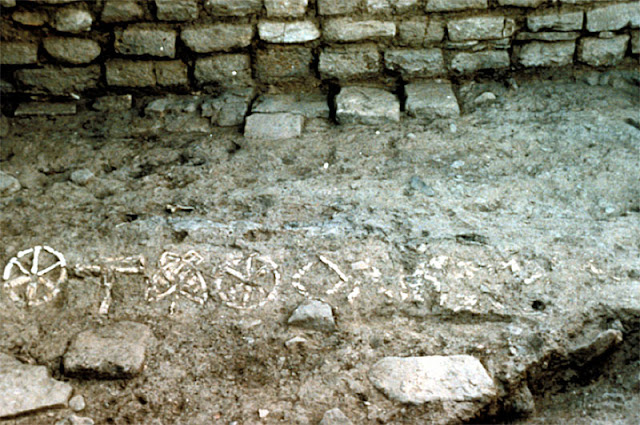

























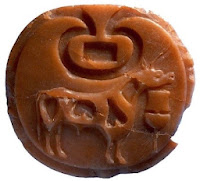
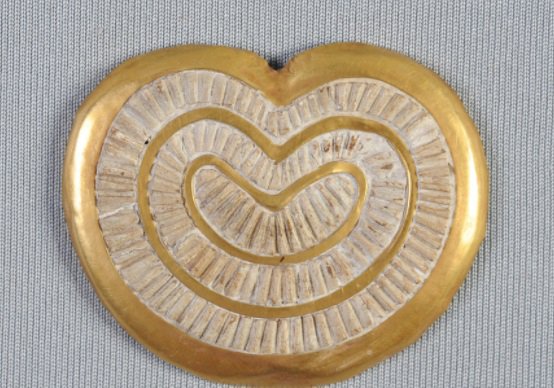

 Seal m0300
Seal m0300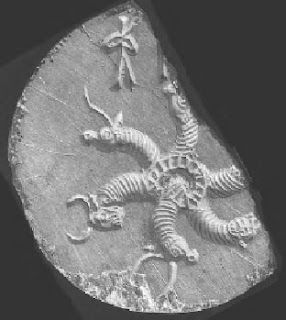





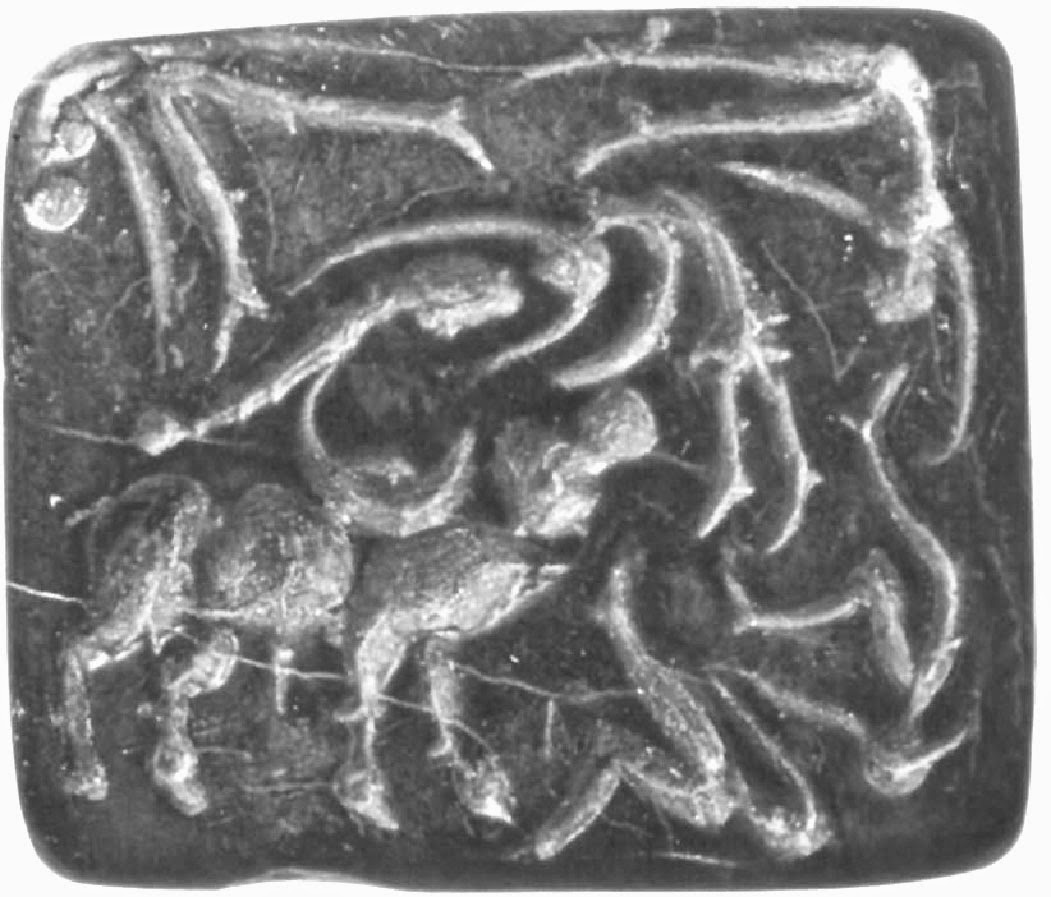


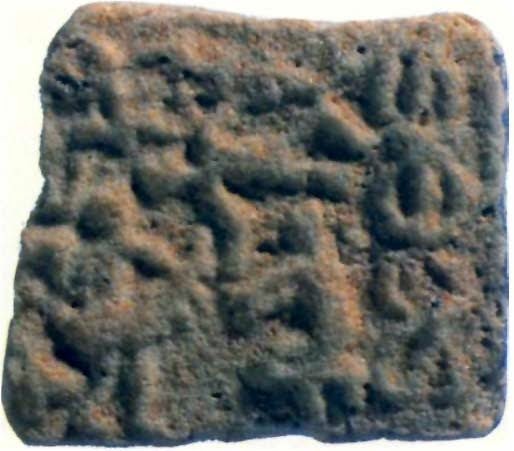
 m1406
m1406
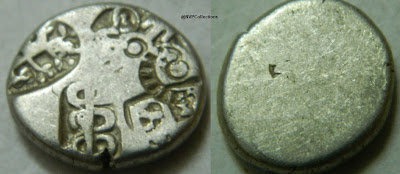 Silver punch-marked coin.
Silver punch-marked coin.













